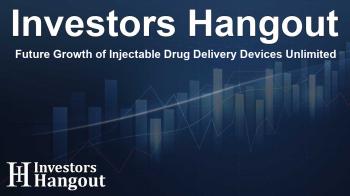Future Growth of Injectable Drug Delivery Devices Unlimited

Exploring the Expanding Injectable Drug Delivery Devices Market
The injectable drug delivery devices market is on the cusp of significant growth, with estimates suggesting it will soar to a remarkable $317.2 billion by 2029. The compound annual growth rate (CAGR) projected at 7.9% reflects the rising need for these devices driven by an increasing prevalence of chronic diseases and a growing elderly population.
Market Insights and Analysis
This analysis dives deep into various aspects such as product types, usage modalities, routes of administration, therapeutic applications, and the diverse end users. The market classifies devices into conventional and advanced categories. Furthermore, usage types are identified as disposable or reusable injectors, with routes of administration including subcutaneous, intramuscular, intravenous, and intradermal administration.
Understanding Market Dynamics
The evolution of the market reflects broader trends across the healthcare landscape. The detailed assessment covers trends, growth projections, and regional insights, encompassing areas like North America, Europe, Asia-Pacific, and beyond. With special focus on distribution channels, key suppliers, and supply chain dynamics, stakeholders can unlock valuable strategic opportunities.
Driving Factors Behind Market Growth
Several critical elements are propelling the injectable drug delivery devices market forward:
- Increasing prevalence of chronic diseases: The rise in diabetes, cancer, and various chronic conditions is directly influencing the demand for these devices, especially as the global population ages.
- Technological advancements: Innovations like wearable injectors and smart delivery systems are not only improving efficiency but also enhancing the patient experience and convenience.
- Preference for self-administration: As patients increasingly favor self-injecting options, the ease of use offered by these devices translates to better adherence to treatment plans.
- Advances in biologics: The surge in biologic drugs necessitates advanced delivery systems capable of managing sensitive therapeutic formulations, adding impetus to market growth.
Key Market Segments and Regional Insights
An essential part of the report is its segmentation insights. The analysis categorizes the market by product, usage modalities, routes of administration, therapeutic applications, and end users, revealing valuable data for targeting specific market niches.
Geographical Distribution of the Market
Regions covered include renowned markets, allowing stakeholders to assess diverse regional opportunities. The insights gleaned can guide decisions for companies looking to expand their reach and enhance their competitive positioning.
Industry Insights
The injectable drug delivery landscape is evolving significantly, driven by innovative technologies that redefine existing paradigms. Novel advancements such as nanoparticles and liposomes are gaining traction, providing essential mechanisms to enhance the stability and bioavailability of therapeutic agents.
By improving solubility, protecting active ingredients from degradation, and facilitating targeted delivery to tissues or cells, these technologies are becoming foundational in modern drug delivery devices.
Frequently Asked Questions
What is the projected market size for injectable drug delivery devices?
The market is anticipated to grow from $204.2 billion in 2023 to $317.2 billion by 2029, at a CAGR of 7.9%.
What factors are driving the growth of this market?
Key drivers include the rising prevalence of chronic diseases, technological innovations, patient preference for self-administered options, and advancements in biologics.
How is the market segmented?
The market is segmented based on product types, usage types, routes of administration, therapeutic applications, end users, and geographical regions.
Which therapeutic application is expected to lead the market?
The diabetes segment is projected to dominate the market by 2029, underscoring the demand for effective management solutions.
Which region holds the largest market share?
North America currently has the largest market share, reflecting its robust healthcare infrastructure and advanced technological adoption.
About The Author
Contact Dominic Sanders privately here. Or send an email with ATTN: Dominic Sanders as the subject to contact@investorshangout.com.
About Investors Hangout
Investors Hangout is a leading online stock forum for financial discussion and learning, offering a wide range of free tools and resources. It draws in traders of all levels, who exchange market knowledge, investigate trading tactics, and keep an eye on industry developments in real time. Featuring financial articles, stock message boards, quotes, charts, company profiles, and live news updates. Through cooperative learning and a wealth of informational resources, it helps users from novices creating their first portfolios to experts honing their techniques. Join Investors Hangout today: https://investorshangout.com/
The content of this article is based on factual, publicly available information and does not represent legal, financial, or investment advice. Investors Hangout does not offer financial advice, and the author is not a licensed financial advisor. Consult a qualified advisor before making any financial or investment decisions based on this article. This article should not be considered advice to purchase, sell, or hold any securities or other investments. If any of the material provided here is inaccurate, please contact us for corrections.

